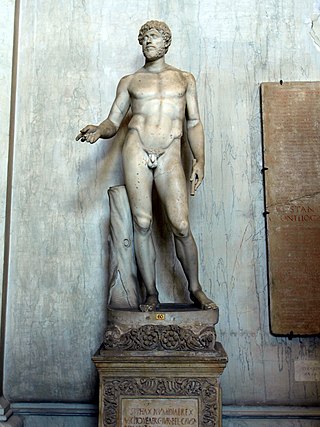Syphax
King of the Masaesyli From Wikipedia, the free encyclopedia
Syphax (Ancient Greek: Σύφαξ, Sýphax;[1] Punic: 𐤎𐤐𐤒, SPQ)[2][3][4] was a king of the Masaesyli tribe of western Numidia (present-day Algeria) during the last quarter of the 3rd century BC. His story is told in Livy's Ab Urbe Condita (written c. 27–25 BC).[5] He ruled over a territory extending from present day Constantine to Moulouya.[6][7]
| Syphax | |
|---|---|
 Statue of a male in the Vatican museum, called "Syphax, King of Numidia" | |
| King of the Masaesyli | |
| Reign | c. 225 – c. 203 BCE |
| Successor | Vermina |
| Died | Tivoli, Roman Republic |
| Spouse | Sophonisba |
| Issue | Vermina Tanakwa |
| Military career | |
| Allegiance | Masaesyli |
| Battles / wars | Second Punic War |
Second Punic War
Summarize
Perspective
When a second war broke out between Carthage and Rome in 218 BC, Syphax was initially sympathetic to the Romans. In 213 BC, he concluded an alliance with the Romans and they sent Quintus Statorius as a military advisor to help Syphax train his troops. He then attacked the rival tribe of eastern Numidians, the Massylians, ruled by King Gala, who at that time were allied to the Carthaginians. When Gala died in 206 BC, his sons Masinissa and Oezalces quarreled about the inheritance, and Syphax was able to conquer considerable parts of the eastern Numidian kingdom.
Negotiations with Rome and Carthage
After the Roman general Publius Cornelius Scipio was victorious in the Battle of Ilipa (206 BC), he sent his friend Gaius Laelius to visit Syphax to ratify the treaty with Rome. Syphax, however, refused to ratify any treaty except with Scipio, so Scipio sailed with two quinqueremes to meet with Syphax, taking a considerable risk in doing so. In fact he arrived at the Numidian harbor at exactly the same time as Hasdrubal Gisco (who had fled from Spain) anchored there on his way back to Carthage. Scipio's ship managed to make harbor before Gisco's seven triremes could make out to intercept them, and in a neutral harbor, Gisco dared not act against the Romans. Syphax invited both to dinner, where both Syphax and Gisco were taken in by Scipio's charm.[5]: p77
Alliance with Hasdrubal
Summarize
Perspective
Meanwhile, Masinissa had concluded that Rome was winning the war against Carthage and therefore decided to switch sides. Having lost the alliance with Masinissa, the Carthaginians started to look for another ally, which they found in Syphax. Hasdrubal Gisco sealed the alliance by offering his daughter Sophonisba in marriage, although until 206 BC she had been betrothed to Masinissa.
Battle of the Great Plains
With the reversal of alliances, it seemed that Carthage and Syphax were in a strong position in Africa. During the early stages of Scipio's campaign in North Africa, the joined forces of Syphax and Gisco were able to force Scipio to abandon the siege of Utica. However, in the 203 BC Battle of the Great Plains, Scipio overcame Gisco and Syphax and while the Roman general concentrated on Carthage, Laelius and Masinissa followed Syphax to Cirta.
Battle of Cirta
During the pursuit, Syphax was threatened with desertion by his army when Laelius and Masinissa's army approached the Numidian battle line. In a brave attempt to rally his troops, Syphax rode alone, straight towards the Roman cavalry, but in this desperate attempt his badly wounded horse threw him off. Syphax was pounced upon immediately by Roman soldiers and taken to the ecstatic Masinissa.[5]: p405 Syphax's troops retreated to the capital city which later fell as Masinissa claimed his kingdom. Syphax was delivered to Scipio and was taken back to Rome as a prisoner. He died in Tibur (modern Tivoli) in 203 or 202 BC.
After death
In a twist of fate, Sophonisba then married Masinissa. However, Scipio, suspicious of Sophonisba, demanded that she be taken to Rome and appear in the triumphal parade. To spare her such humiliation, Masinissa sent her poison, with which she killed herself.
References
External links
Wikiwand - on
Seamless Wikipedia browsing. On steroids.
